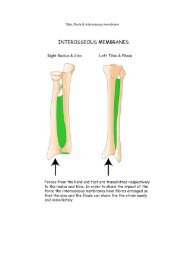GSM 11.11 version 6.2.0 - TTFN Smart card pages
GSM 11.11 version 6.2.0 - TTFN Smart card pages
GSM 11.11 version 6.2.0 - TTFN Smart card pages
- No tags were found...
You also want an ePaper? Increase the reach of your titles
YUMPU automatically turns print PDFs into web optimized ePapers that Google loves.
(<strong>GSM</strong> <strong>11.11</strong> <strong>version</strong> <strong>6.2.0</strong> Release 1997)89TS 100 977 V<strong>6.2.0</strong> (1999-05)When involved in <strong>GSM</strong> network operations the SIM interfaces with an ME with which messages are exchanged. Amessage can be a command or a response.- A <strong>GSM</strong> command/response pair is a sequence consisting of a command and the associated response.- A <strong>GSM</strong> procedure consists of one or more <strong>GSM</strong> command/response pairs which are used to perform all orpart of an application-oriented task. A procedure shall be considered as a whole, that is to say that thecorresponding task is achieved if and only if the procedure is completed. The ME shall ensure that, whenoperated according to the manufacturer's manual, any unspecified interruption of the sequence ofcommand/response pairs which realize the procedure, leads to the abortion of the procedure itself.- A <strong>GSM</strong> session of the SIM in the <strong>GSM</strong> application is the interval of time starting at the completion of theSIM initialization procedure and ending either with the start of the <strong>GSM</strong> session termination procedure, or atthe first instant the link between the SIM and the ME is interrupted.During the <strong>GSM</strong> network operation phase, the ME plays the role of the master and the SIM plays the role of the slave.Some procedures at the SIM/ME interface require MMI interactions. The descriptions hereafter do not intend to inferany specific implementation of the corresponding MMI. When MMI interaction is required, it is marked "MMI" in thelist given below.Some procedures are not clearly user dependent. They are directly caused by the interaction of the MS and the network.Such procedures are marked "NET" in the list given below.Some procedures are automatically initiated by the ME. They are marked "ME" in the list given below.The list of procedures at the SIM/ME interface in <strong>GSM</strong> network operation is as follows:General Procedures:- Reading an EF ME- Updating an EF ME- Increasing an EF MESIM management procedures:- SIM initialization ME- <strong>GSM</strong> session termination ME- Emergency call codes request ME- Extended language preference request ME- Language preference request ME- Administrative information request ME- SIM service table request ME- SIM phase request MECHV related procedures:- CHV verification MMI- CHV value substitution MMI- CHV disabling MMI- CHV enabling MMI- CHV unblocking MMI<strong>GSM</strong> security related procedures:- <strong>GSM</strong> algorithms computation NET- IMSI request NET- Access control information request NET- HPLMN search period request NET- Location Information NET- Cipher key NET- BCCH information NET- Forbidden PLMN information NETETSI








